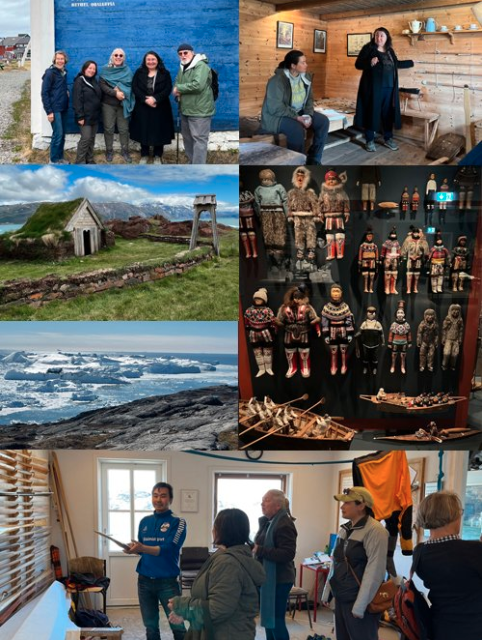Programs of AFI
Indigenous Cultural Exchange: Greenland
In June, in collaboration with the Arctic Futures Institute, W2O lead a delegation of indigenous artists from Maine to explore living cultural traditions and potential exchange with indigenous artists and institutions in Greenland. Mihku Paul Anderson, poet and artist, and Jennifer Neptune, basket maker and curator of the Penobscot Indian Museum, joined with W2O director Peter Neill and artist Mary Barnes to discuss and develop future collaboration in the form of shared exhibits, workshops, residencies, youth training and experience, and educational programs relating to a shared landscape, history, and cultural tradition for 2023 and beyond. In addition, W2O tested its smartphone interpretation app (available in the App Store), created in 2020, as a information tool for visitors to Kujataa, the southernmost Heritage Site in Greenland. The app is being marketed and distributed by Visit Greenland and other tourist promoters at no cost to users. Future apps were discussed for the Sisimiut Heritage Site and for the National Museum and local cultural environs in Nuuk. The project was supported by two foundations and anonymous donors from Maine.

(clockwise from upper left)
1. Team portrait at Sisimuit Kangerlussuaq Museum: Mary Barnes, Jennifer Neptune, Mihku Paul Anderson, Dorthe Katrine Olsen, Sisimiut Museum director, Peter Neill; 2. Dorthe Katrine Olsen, Museum Director at Sisimiut & Kangerlussuaq Museum (and first indigenous female museum director in Greenland) Explaining exhibits; 3. Traditional costume dolls, National Museum, Nuuk; 4. lulusaat kayak lesson; 5. The ice, World Heritage landscape 6. First Christian church, Kujataa.
ArcticEarth
A 5-year commitment by Compass Light Productions to position a vessel and a professional boat crew in the new Arctic, extending 30 years of filmmaking work in the area. The 56′ aluminum s/v ArcticEarth can also be booked for full vessel charter by other media-makers, field researchers, & private groups of 6 or fewer people. Subscribe to the ArcticEarth Journal for news and updates, director reports, and expedition discoveries. FMI: arcticearth-charter.com/journal
Arctic Circle Assembly-Iceland
MITC’s Maine North Atlantic Development Office (MENADO) led a 30 person Maine delegation at the Arctic Circle Assembly in Reykjavik, Iceland in October for Maine academic and institutional leaders and businesses. MENADO organized Maine delegation meetings and events, as well as a schedule of high-level meetings. 14 Mainers presented in breakout sessions at the Assembly.
Greenland Summer Workshop June 2019
AFI held its summer workshop in Greenland with UMaine specialists and Greenlanders to discuss a research and planning strategy for Kujataa, a World Heritage Site recently designated by UNESCO. Scientists, educators, lawyers, policy experts, artists, and national, regional, and local leaders will gather to explore novel approaches and viable solutions for research and development in the area in ways that will benefit the surrounding communities and the protection, investigation, and interpretation of the site as a cultural resource. Kujataa is a subarctic farming landscape located in the south coastal region of Greenland. It bears witness to the cultural histories of the Norse farmer-hunters who started arriving from Iceland in the 10th century and of the Inuit hunters and farming communities that developed from the end of the 18th century. Despite their differences, the two cultures, European Norse and Inuit, created a cultural landscape based on farming, grazing and marine mammal hunting. The landscape represents the earliest introduction of farming to the Arctic, and the Norse expansion of settlement beyond Europe.
Greenland Summer Workshop June 2018
In June of 2018 the AFI convened the first-ever Arctic Summer Institute in Portland, Maine. We brought together together law and climate students, climate scientists, interested individuals, and experts on policy, the Law of the Sea, and the capacity to model future climate conditions and consequences through innovative analysis of existing historical data.
In addition to these presentations, we engaged in a process of investigation from a definition of goals, trends and factors to application of predictions and innovations, with teams comprising disciplines and interests addressing the process in the context of specific challenging issues. It was an intense and constructive exercise and gave proof of the concept that a small, concentrated, interdisciplinary group of thinkers, representing all constituencies, can create a liberating exploration of “plausible scenarios” in search of an inventive, viable, alternative future.


